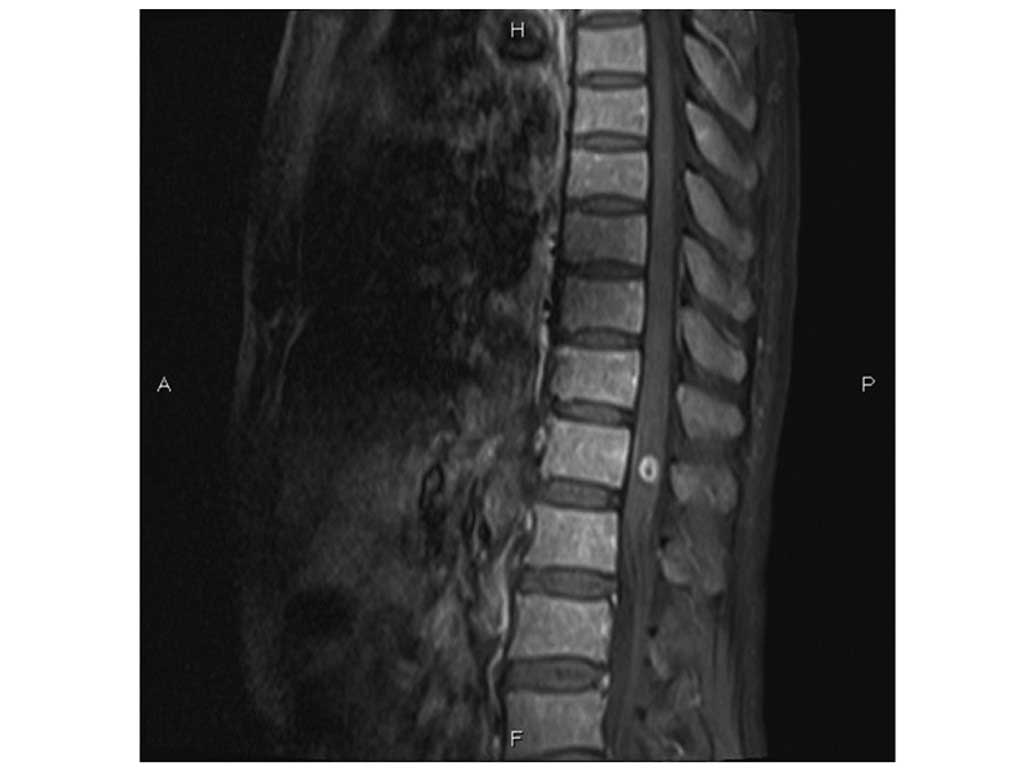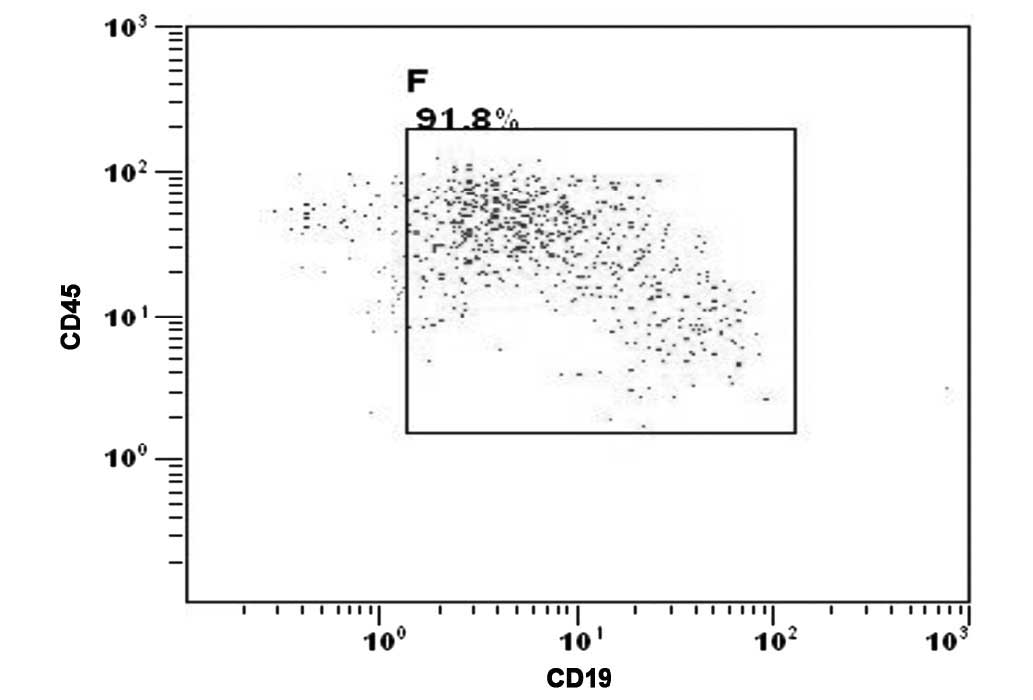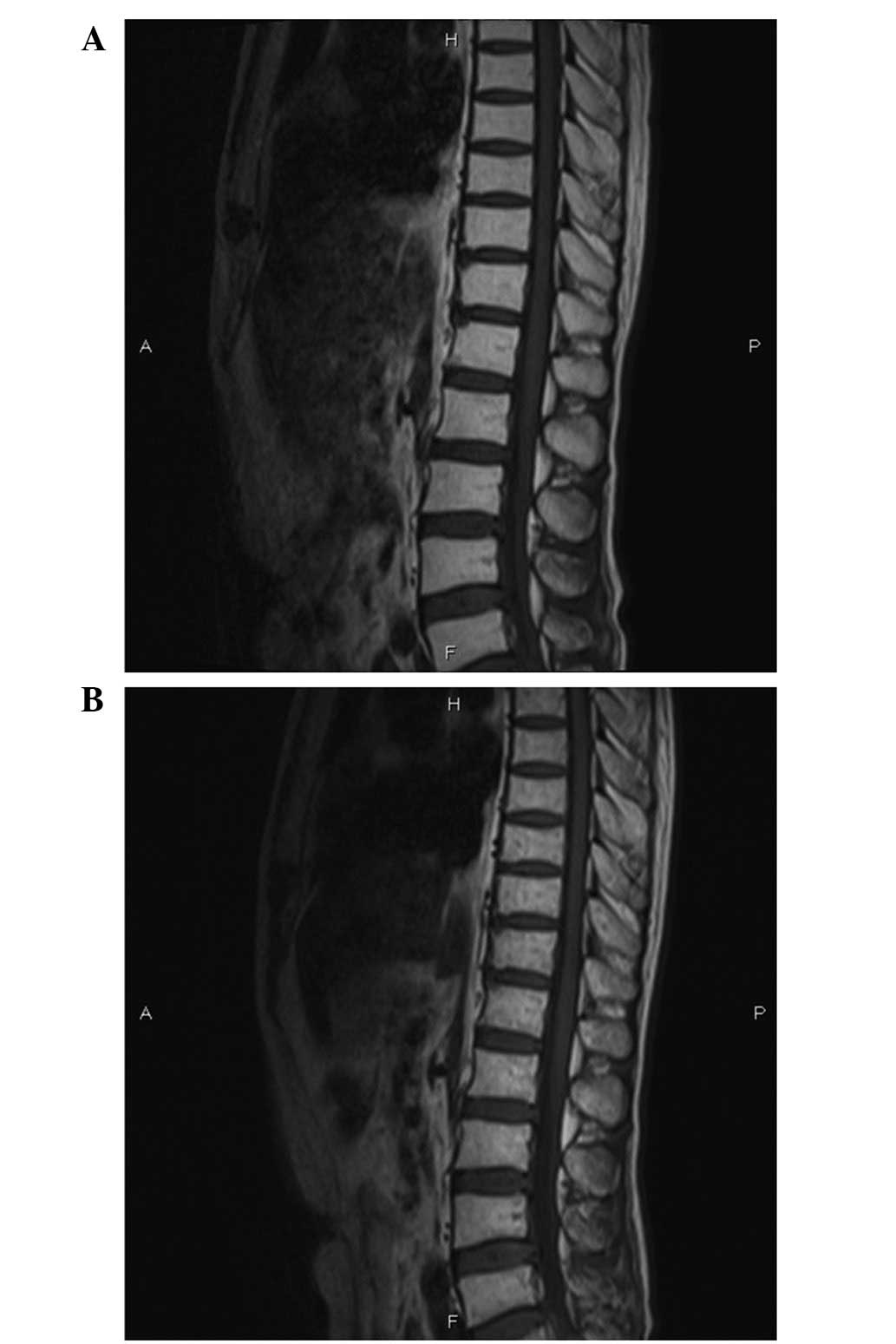Transverse myelopathy occurring with intrathecal administration of methotrexate and cytarabine chemotherapy: A case report
- Authors:
- Published online on: May 4, 2016 https://doi.org/10.3892/ol.2016.4519
- Pages: 4066-4068
Abstract
Introduction
Acute lymphocytic leukemia (ALL) is a malignant hematological disease, which originates from B or T lymphoid progenitor cells (1). The central nervous system (CNS) is a region in which direct infiltration and involvement or relapse occurs in adults with ALL (1). If no preventative therapy is administered, a total of 30–50% of adults with ALL eventually present with CNS leukemia (CNSL) (2). Following advances in chemotherapy and effective CNS prophylaxis, the incidence of CNS relapse in cases of ALL has decreased to 5–10% (1). Intrathecal administration of chemotherapy, high dose chemotherapy and brain radiotherapy are the primary measures used for the prevention of CNSL (3,4).
The central nervous system (CNS) has long been recognized as a site, and indeed a sanctuary, for leukemic cells (1). However, few patients (<5%) with ALL present with overt CNSL initially (1). The clinical manifestation of CNSL ranges from mild to severe, and infiltration of the arachnoid membrane and dura mater is the most common, followed by the brain parenchyma and cranial nerves; spinal cord infiltration is the most rare presentation (1,3,4).
The most commonly used treatment for CNSL is intrathecal (IT) administration of chemotherapy (1,3–5). However, IT chemotherapy is associated with certain complications, which most frequently include peripheral neuropathy, cranial neuropathies, acute encephalopathy, acute vasculopathies, headaches and seizures (5). Transverse myelopathy is a rare complication (5). The current study reports the case of a patient who experienced a reversible spinal cord injury as clinical feature, and subsequently developed irreversible spinal cord injury following the IT administration of methotrexate (MTX) and cytarabine (Ara-C).
Case report
A 46-year-old man was diagnosed with B-cell ALL (Philadelphia chromosome-positive and hyperleukocytosis) morphology, immunology, cytogenetics and molecular biology by morphology, immunology, cytogenetics and molecular biology at The Second Hospital of Anhui Medical University (Hefei, China) in November 2012. Philadelphia chromosome was tested using the G-banding technique, and a routine blood test demonstrated that the white blood cell count was 32.93×109/l, which indicated the presence of hyperleukocytosis. The patient underwent induction chemotherapy consisting of DVCP (daunorubicin 80 mg, day 1, 15 and 22; vindesine 4 mg, day 1, 8, 15 and 22; cyclophosphamide 1.0 g, day 1 and 15; and desamethasone 15 mg, days 1–28) plus imatinib (400 mg, days 19–28) for 1 cycle. However, in January 2013, the patient developed a sudden onset of numbness in his two lower limbs (also known as transverse myelopathy) in addition to bladder incontinence, shortly after achieving remission in the blood and bone marrow following the initial course of chemotherapy. Magnetic resonance (MR) imaging (MAGNETOM Verio 3.0T; Siemens AG, Munich, Germany) revealed lymphomatous infiltration at the T12 vertebra (Fig. 1A). Leukemic infiltration of the CNS was confirmed by the presence of malignant leukemia cells detected in the cytospin of the cerebrospinal fluid (CSF) (Fig. 2).
The patient was subsequently administered IT (via the 3rd and 4th lumbar intervertebral space) MTX (15 mg) and Ara-C (50 mg) immediately following a diagnostic lumbar puncture every other day 8 times, without other therapy, from January 7 to 21, 2013. After experiencing CNSL remission, the patient was given IT MTX (10 mg), Ara-C (50 mg) and dexamethasone (10 mg) once per week for 4 weeks. Soon after the completion of IT injections, the patient reported feeling that his numbness and bladder incontinence had recovered. Repeat MR imaging showed no infiltration in the spinal cord (Fig. 3A). The patient was subsequently administered consolidation chemotherapy once consisting of cyclophosphamide (1.2 g; day 1), vincristine (2 mg; day 1), Ara-C (0.2 g; days 1–5), teniposide (150 mg, days 1–4) and dexamethasone (10 mg; days 1–7) for 1 cycle.
However, in April 2013, the patient developed a sudden onset of paraplegia and urinary retention again. Repeat MR imaging of the spine and brain revealed no evidence of disease progression, spinal cord compression or brain metastasis (Fig. 3B). A repeat CSF examination during this neurological event was normal. Supportive treatment, which included neuro nutrition drugs, was administered accordingly; however, the paraplegia was irreversible. The patient gave up further treatment due to economic factors in May 2013, and at the last follow-up the numbness and bladder incontinence had alleviated, but had not fully recovered.
Discussion
The CNS is a location in which direct infiltration and involvement or relapse may occur in ALL (1). The majority of ALL relapses occur during treatment or within the first 2 years after the completion of treatment; however, relapses have been reported to occur even 10 years after diagnosis. The main mechanism of CNS infiltration in leukemia is associated with blood brain barrier (7). CNSL most frequently involves infiltration of the arachnoid membrane and dura mater, less commonly the brain parenchyma, choroid glands and cranial nerve, and rarely the spinal cord (5).
There are several high risk factors associated with the occurrence of CNSL, including hyperleukocytosis at diagnosis, the presence of extramedullary infiltration, certain types of acute leukemia [including acute myelomonocytic leukemia and acute monocytic leukemia (M5a)], T-cell immunophenotype, Burkitt's lymphoma (mature), relapsed acute promyelocytic leukemia, and high-risk genetic abnormalities [such as t(4;11) and the Philadelphia chromosome] (8). The current patient, who developed the symptom of paraplegia, had two high risk factors for CNSL: Hyperleukocytosis at diagnosis and the Philadelphia chromosome.
There are numerous methods for the treatment of CNSL, including IT chemotherapy, systemic chemotherapy and radiation therapy (9). The role of IT chemotherapy has been emphasized in modern clinical usage; however, it is associated with various possible side effects. Transverse myelopathy, which is defined as the development of isolated spinal cord dysfunction over hours or days in the absence of a compressive lesion, is an unusual complication of IT MTX/Ara-C chemotherapy (10–12). The most important MTX-associated risk factors for the development transverse myelopathy are high dose IT MTX, systemic MTX, repeated injection with an interval of <1 week, concurrent use with other medication or cranial radiotherapy, and active CNS disease (13,14). The symptoms usually develop between several minutes and 2 weeks after treatment (13,14); however, the current patient developed the neurological symptoms 3 months after the first administration of IT MTX and Ara-C.
Although the incidence of transverse myelopathy is low (~3% of all patients who undergo intrathecal injection) and its occurrence is unpredictable, doctors must be aware of this complication and attempt to avoid the aforementioned high risk factors (15). Once the complication has occurred, administration of IT MTX or Ara-C must be discontinued and the patient should be reassured (15).
In conclusion, the most vital difference between the current case and other cases in which transverse myelopathy developed was that the neurological symptoms of the current patient were identical when he developed CNSL and when the complication of the subsequent IT chemotherapy occurred. To distinguish the two is crucial as the appropriate therapies for each are completely opposite (5). It is advisable to monitor the CSF by light microscopy and flow cytometry. Repeated MR imaging must also be conducted.
Acknowledgements
This study was supported by the Foundation of Anhui Medical University (grant no. 2015xkj018) and the National Natural Science Foundation of China (grant no. 81401293).
References
|
Sung SH and Jang IS: Isolated central nervous system relapse of acute lymphoblastic leukemia. Brain Tumor Res Treat. 2:114–118. 2014. View Article : Google Scholar : PubMed/NCBI | |
|
Mahmoud HH, Rivera GK, Hancock ML, Krance RA, Kun LE, Behm FG, Ribeiro RC, Sandlund JT, Crist WM and Pui CH: Low leukocyte counts with blast cells in cerebrospinal fluid of children with newly diagnosed acute lymphoblastic leukemia. N Engl J Med. 329:314–319. 1993. View Article : Google Scholar : PubMed/NCBI | |
|
Pui CH, Sandlund JT, Pei D, Campana D, Rivera GK, Ribeiro RC, Rubnitz JE, Razzouk BI, Howard SC, Hudson MM, et al: Total Therapy Study XIIIB at St Jude Children's Research Hospital: Improved outcome for children with acute lymphoblastic leukemia: Result of Total Therapy Study XIIIB at St Jude Children's Research Hospital. Blood. 104:2690–2696. 2004. View Article : Google Scholar : PubMed/NCBI | |
|
Lange B, Bostrom B, Cherlow JM, Sensel MG, La MK, Rackoff W, Heerema NA, Wimmer RS, Trigg ME and Sather HN: Children's Cancer Group: Double-delayed intensification improves event free survival for children with intermediate-risk acute lymphoblastic leukemia: A report from the Children's Cancer Group. Blood. 99:825–833. 2002. View Article : Google Scholar : PubMed/NCBI | |
|
Del Principe MI, Maurillo L, Buccisano F, Sconocchia G, Cefalo M, De Santis G, Di Veroli A, Ditto C, Nasso D, Postorino M, et al: Central nervous system involvement in adult acute lymphoblastic leukemia: Diagnostic tools, prophylaxis, and therapy. Mediterr J Hematol Infect Dis. 6:e20140752014. View Article : Google Scholar : PubMed/NCBI | |
|
Blasberg RG, Patlak C and Fenstermacher JD: Intrathecal chemotherapy: Brain tissue profiles after ventriculocisternal perfusion. J Pharmacol Exp Ther. 195:73–83. 1975.PubMed/NCBI | |
|
Zhou W and Li JM: Mechanism and early evaluation of CNS infiltration in acute lymphocytic leukemia-review. Zhongguo Shi Yan Xue Ye Xue Za Zhi. 21:1361–1364. 2013.(In Chinese). PubMed/NCBI | |
|
Pui CH and Howard SC: Current management and challenges of malignant disease in the CNS in paediatric leukaemia. Lancet Oncol. 9:257–268. 2008. View Article : Google Scholar : PubMed/NCBI | |
|
Sherman PM, Belden CJ and Nelson DA: Magnetic resonance imaging findings in a case of cytarabine-induced myelopathy. Mil Med. 167:157–160. 2002.PubMed/NCBI | |
|
Gagliano RG and Costanzi JJ: Paraplegia following intrathecal methotrexate: Report of a case and review of the literature. Cancer. 37:1663–1668. 1976. View Article : Google Scholar : PubMed/NCBI | |
|
Dunton SF, Nitschke R, Spruce WE, Bodensteiner J and Krous HF: Progressive ascending paralysis following administration of intrathecal and intravenous cytosine arabinoside. A pediatric oncology group study. Cancer. 57:1083–1088. 1986. View Article : Google Scholar : PubMed/NCBI | |
|
Werner RA: Paraplegia and quadriplegia after intrathecal chemotherapy. Arch Phys Med Rehabil. 69:1054–1056. 1988.PubMed/NCBI | |
|
Bleyer WA and Dedrick RL: Clinical pharmacology of intrathecal methotrexate. I. Pharmacokinetics in nontoxic patients after lumbar injection. Cancer Treat Rep. 61:703–708. 1977.PubMed/NCBI | |
|
Miller KT and Wilkinson DS: Pharmacokinetics of methotrexate in the cerebrospinal fluid after intracerebroventricular administration in patients with meningeal carcinomatosis and altered cerebrospinal fluid flow dynamics. Ther Drug Monit. 11:231–237. 1989. View Article : Google Scholar : PubMed/NCBI | |
|
Teh HS, Fadilah SAW and Leong CF: Transverse myelopathy following intrathecal administration of chemotherapy. Singapore Med J. 48:e46–e49. 2007.PubMed/NCBI |












